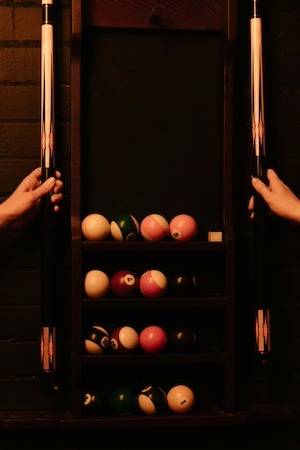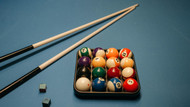Billiards Cue vs Pool Cue: One Game-Changing Choice You Need to Make
Posted by Home Billiards on 12th Nov 2025
Think all cues are the same? Think again.
That sleek stick you see gliding across the felt can make or break your game - but only if it’s the right one. Whether you’re lining up a clean break in pool or finessing a precision carom shot in billiards, your cue isn’t just a tool; it’s an extension of your strategy and style.
In this article, you’ll discover:
- What truly separates a billiards cue from a pool cue (hint: it’s more than just size).
- How to choose the right cue based on your game, grip, and goals.
- Why materials like carbon fiber are changing how players think about maintenance and performance.
Written by cue sport enthusiasts who know their way around both the pocketed and pocketless tables, this guide will help you pick a cue that feels right in your hands and improves every shot you take.
So before you buy your next cue - or blame your last miss on your equipment - read on to find out what really sets these sticks apart.
What Is a Billiards Cue?
A billiards cue is a tapered stick used to strike balls in games like pool, snooker, and carom billiards. Standard cues are 57–59 inches long and made from wood or fiberglass. The narrow tip contacts the cue ball to control direction, spin, and power during play.
What Is a Pool Cue?
A pool cue is a long, tapered stick used to strike the cue ball in cue sports like pool. Standard pool cues measure 58 inches and are made of hardwood, often maple. The cue’s tip applies spin and control, allowing players to direct shots with precision on a pool table.
Key Differences Between a Billiards Cue and a Pool Cue
The main difference between a billiards cue and a pool cue is the tip size and design. Billiards cues have smaller tips (10–11 mm) for precise spin in carom games, while pool cues have larger tips (12–13 mm) for controlling the cue ball in pocketed games. Billiards cues also lack a joint collar and are shorter.
|
Feature |
Billiards Cue |
Pool Cue |
|
Cue Tip Size |
Smaller (≈11–12 mm) |
Larger (≈12–13 mm) |
|
Shaft Diameter |
Thicker |
Thinner |
|
Weight |
Heavier |
Moderate |
|
Balance Point |
Toward the front |
More centered |
|
Grip |
Smooth / no wrap |
Linen or leather wrap |
|
Intended Use |
Carom / no pockets |
Pocket billiards |
Choosing the Right Cue for Your Game

Alt tag: billiard balls arranged on wall rack with hands holding two cue sticks under warm lighting.
The first thing to consider is which cue sport you will play most often. This will determine the type of cue you should focus on purchasing. From here, you’ll want to start looking at the best pool cue brands to get a sense of what a good quality cue looks like.
Your first cue should be a general-purpose cue. After that, you can branch out to purchase specialized cues like a break cue or jump cue. Try different wraps when buying a pool cue, and consider a low-deflection cue, which we explain in more detail in our article Low Deflection Cues Explained.
Lastly, consider the maintenance requirements of your cue. Carbon cues are considered lower maintenance than wood cues since they don’t warp or need the same care to keep them in top condition. However, carbon cues are generally more expensive, so low maintenance can come at a cost in the short run.
Where to Find Quality Pool and Billiards Cues
To find a quality pool or billiards cue, you can look online or in a billiards supply store like Home Billiards. New cues typically come with a warranty, so it’s best to shop at an authorized dealer. These shops will have knowledgeable staff and support to help you along the way.
Used cues are fine too; you can find them on Facebook Marketplace, eBay or Craigslist. Just be extra cautious of warping or damaged parts. Cue tips can usually be replaced, but if the ferrule is broken, a more extensive fix will be needed. With that in mind, an in-person inspection is ideal.
Conclusion: What Cue is Right for You?
The right cue doesn’t just affect how you strike the ball — it affects how you see the table. Whether you’re refining your control in carom billiards or sharpening your precision in pool, choosing a cue that matches your style, goals, and preferred game gives you a noticeable competitive edge. From tip size and balance point to shaft material and grip, these details shape the confidence behind every shot you take.
If you’re ready to upgrade your game, don’t settle for a one-size-fits-all cue. Experiment with different materials, test how various wraps feel in your hand, and pick a cue that enhances your technique rather than working against it. The right cue should feel like a natural extension of your intentions on the table.
Ready to find your perfect match? Explore premium cues for sale and level up your game with quality equipment built for performance. Your best shots start with the right cue in your hands.

Are billiard cues and pool cues interchangeable?
Billiard cues and pool cues are not fully interchangeable. Billiard cues are shorter, heavier, and have a smaller tip diameter to suit carom games, while pool cues are longer with larger tips for controlling pool balls. Using the wrong cue can affect accuracy, spin, and overall performance.
Can you use a pool cue for carom billiards?
You can use a pool cue for carom billiards, but it is not ideal. Pool cues have larger tips and are designed for larger balls, which can reduce control and accuracy in carom games. Carom cues are shorter, heavier, and have smaller tips to handle precision and spin on a smaller table.
What’s the ideal cue tip size for pool vs billiards?
The ideal cue tip size for pool is 12 to 13 millimeters, allowing better control over spin and shot variety. For carom billiards, the ideal tip size is 11 to 12 millimeters, offering more precision and power transfer due to the heavier balls and smaller playing surface.

